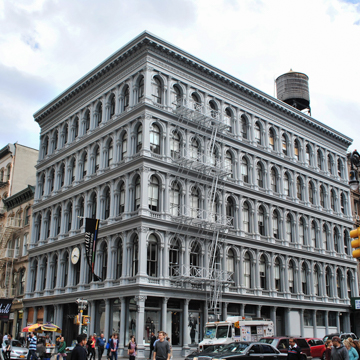The Haughwout Building’s handsome facade blends in almost too well with its neighbors in New York City’s SoHo district, modestly hiding its intriguing origins. It was the original home of one of the most revolutionary building technologies: the passenger elevator. Its cast-iron construction was a precursor to the steel-framed high-rise.
Today the building sits on the edge of the popular SoHo shopping district. When it was built in 1857, it was a part of a fashionable commercial district on lower Broadway. The structure was erected to house Eder V. Haughwout’s luxury goods store, which offered items such as handcrafted and imported china and glass that attracted a prominent clientele, including Mary Todd Lincoln, who bought china for the White House there.
Although not the first or largest commercial building with a cast-iron facade, the Haughwout Building was unusual for having two cast-iron facades. It was also the first structure to house an elevator, designed by Elisha H. Otis, explicitly for passenger use. This was an astute commercial move, as it made the upper levels easily and dramatically accessible to the store’s wealthy clients. In doing so, it helped stimulate the urge to building vertically, forecasting the era of the skyscrapers that have since dominated the city’s skyline.
The building’s crisply detailed Renaissance Revival facade, designed by John P. Gaynor, is a lesson in drama through repetition: each of the building’s five stories is defined by a colonnade of regularly spaced, engaged Corinthian columns, which flatten into pilasters to turn the corner from Broadway to Broome Street. Above street level, Gaynor used a single motif 92 times across the facade, filling the space between each column with Corinthian colonnettes supporting an elaborately keystoned arch and flanking large round-headed windows. The repetition of the prefabricated parts highlights the mass-production associated with the then new building technology of cast iron. This technology, along with elevators, paved the way for modern skyscraper construction and the minimalist steel and glass aesthetic later associated with it. They also freed up more interior space to display Haughwout’s goods, and over time, enabled the building to accommodate a variety of other stores and functions.
The cast Corinthian columns of the facade are said to mimic those of the Renaissance Sansovino Library in Venice. This mimesis was made possible by intricately carved molds produced by the fabricator, Daniel D. Badger, whose Architectural Iron Works were located on East 14th Street. Using cast-iron also allowed for wide window openings that allowed Haughwout’s expensive goods to be well lit and easily seen from the street through the show rooms on the ground level. Badger noted this feature in his book, Illustration of Iron Work s: “a light and ornamental edifice of iron may be safely substituted for the cumbrous structures of other substances, and sufficient strength be secured without exclusion of light—which is often highly desirable for mercantile and mechanical purposes.” Along with James Bogardus, Badger and his firm were the most successful manufacturers and exporters of cast-iron buildings.
Unlike the Haughwout, most of its cast-iron neighbors (the majority of which were built between 1850 and 1890) housed light manufacturing concerns. With the rapid decline of urban manufacturing after World War II, by 1962 the overlooked neighborhood was deemed by city officials to be a “commercial slum” with “no buildings worth saving”—a conclusion with which preservationists disagreed. The nascent Landmarks Preservation Commission (LPC) joined the fray, calling the Haughwout “the Parthenon of New York’s Iron Age” to make its significance explicit. The Commission attempted to convince Mayor Robert Wagner to halt Robert Moses’s 20-year-old proposal for a cross-town expressway, with a goal of saving the Haughwout and its cast-iron neighbors. With the area’s fate still being debated, urban planner Chester Rapkin argued that the cast-iron building stock was far from obsolete and was well suited to a variety of uses and occupants. He specifically cited the artists who had already begun to move to the area in search of large spaces in which to live and work. It was in Rapkin’s report that the district south of Houston Street became SoHo.
In 1965, with the threat of Moses’s expressway still very real, and on the heels of the demolition of Penn Station, the Haughwout Building was one of the first buildings in the city to receive official landmark status from the LPC. This designation ultimately helped scuttle the expressway plan, saving the Haughwout and SoHo. But while the buildings were spared, the character of the neighborhood quickly changed. By 1970, the New York Times claimed that the neighborhood was rapidly transitioning from grimy to arty to chic. The SoHo Cast-Iron Preservation District was formally established in 1973 and by the 1980s, the neighborhood had largely gentrified. As the art galleries decamped to Chelsea in the late 1980s and early 1990s, retailers, including chains and boutiques, moved into the storefronts they had abandoned.
Since becoming a landmark, the Haughwout has been adapted for new purposes. While its ground floor still contains retail and commercial space, the upper floors have been converted to high-end rental apartments. In the early 1990s, the building’s owners hired the architect Joseph Pell Lombardi to oversee the restoration of the facades. Missing and deteriorated elements were recast and reinstalled and the exterior was cleaned and repainted in what were supposedly its original colors. The Haughwout continues to represent New York’s architectural heritage as a prime example of the flexible integration of form with function, an integration made possible by its innovative building technology and adaptability of design.
References
Diamonstein-Spielvogel, Barbaralee, ed. “E.V. Haughwout Building.” The Landmarks of New York.5th ed. Albany, NY: SUNY Press, 2011.
Huxtable, Ada Louise. “Noted Buildings in Path of Road; Cast-Iron Structures on Broome St. Seem Slated to Go for Expressway.” New York Times, July 22, 1965.
Huxtable, Ada Louise. “Architecture; Good Buildings Have Friends.” New York Times,May 24, 1970.
Sturges, W. Knight. The Origins of Cast Iron Architecture in America. New York: Da Capo Press, 1970.

